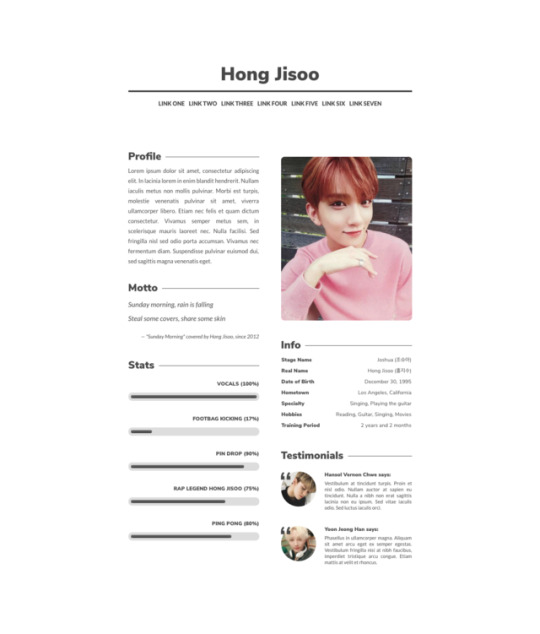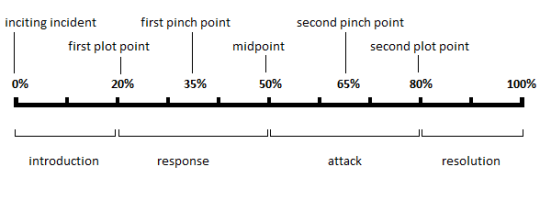Minnie, 20, Writerblr. I'm on hiatus right now due to reasons This is my main account for all my official writing stuff and other general writing things! Current WIP is "The Art of Buying Souls" which is in the planning stage right now. @therapeuticwriting is my side blog for more unofficial writing things and personal stuff.
Don't wanna be here? Send us removal request.
Text
for all you writers out there:
donjon has tons of generators. for calendars. for demographics of a country and city. for names (both fantastical and historical) of people, nations, magics, etc.
this site lets you generate/design a city, allowing you to choose size, if you want a river or coast, walls around it, a temple, a main keep, etc.
this twitter, uncharted atlas, tweets generated maps of fantasy regions every hour.
and vulgar allows you to create a language, based on linguistic and grammatical structures!!! go international phonetic alphabet!!!
62K notes
·
View notes
Text
How To Write A Book Pitch
This is what you say when someone says ‘what’s the book about?’—a paralyzing question, and you need a compelling answer.
If you don’t know where to start,
A very basic formula for a book pitch can go something like this—
Character, conflict, setting, hook
Character
Most pitches start with character.
A charming cyborg…
A relentless assasin…
A battered detective…
(Try to keep it to one interesting character, too many characters at once can be confusing.)
Conflict
This is the problem your character faces. This is whatever your plot is.
…gets stranded on mars…
…falls in love with the man she’s supposed to kill…
…uncovers a dangerous secret…
Setting
…in a world ravaged by famine…
…lost in an unforgiving sea…
…at an elusive liberal arts college…
Hook
THIS is the part that is tricky, because there’s no easy formulaic way I can suggest you end your pitch—but you should have a hook, something snappy that pulls you in.
Example:
Under this formula, the pitch for my novel, ‘The Runaway’s Promise’ would look something like this…
Creative foster kid Beverly wants nothing more than to run away from her fatally dull small-town home. In trying to make an escape plan, she gets caught in a dangerous town secret that threatens to keep her there forever.
3K notes
·
View notes
Photo


17 Project: Joshua
This is the second theme pack of my 17 Project series.
Theme (Preview, Terms of Use, Code: Pastebin / Pasted)
Features:
17 color options
250 x 370px sidebar image
custom sidebar image “shadow” background
custom post width
custom blog title
up to 6 custom links
reblog button
show/hide captions and tags
pagination
About Page (Preview, Terms of Use, Code: Pastebin/Pasted)
Features:
header with name and up to 7 custom links
300px image (automatically resizes)
profile section
quote section
stat section with customizable progress bars
basic info section
testimonial section; a scrollbar will appear if your text gets too long
A like or reblog would be appreciated if you are planning to use my codes! Please direct all your questions and feedback here.
2K notes
·
View notes
Text
Testing out popular (FREE) writing hacks
There are a lot of writing hacks floating around, tips that are supposed to increase your writing productivity. Well, I tested them, and here are my thoughts:
1. Use Comic Sans
Let’s be honest. When we were in primary school, we typed EVERYTHING in Comic Sans. However, as we got older and more professional, Comic Sans appeared childish and we stopped using it.
Ask anyone what the most unprofessional font is and they’ll probably answer: Comic Sans MS
However, earlier this year the idea of using Comic Sans when writing your first draft started popping up and now, a lot of writers are swearing by it.
So, did it increase my productivity?
YES
I started writing a scene in Comic Sans and I wrote about five pages in like 30 minutes. The words just flowed. I don’t know why this font increases writing productivity, but if it works, I don’t really care why.
So, I would 100% recommend trying Comic Sans for your first draft. Remember, no one’s going to see it. And it’s pretty easy to change back to something like Times New Roman once you’ve finished a scene.
2. Dictation
I’ve heard a lot of professional authors rave about how much time they save by dictating their first drafts. However, a lot of dictation software and microphones are quite expensive. So, I tried the free alternatives at my disposal.
The latest version of OneNote, which comes included in a lot of Microsoft Office packages, now has a dictation feature. I know this isn’t technically free, but it was for me, since I already have Office installed. The OneNote mobile app is free, but I don’t know it is has this feature. And I just used the built-in microphone on my laptop. Google Docs also has a dictation feature, I think, but I haven’t tried it yet.
So, does it work?
The accuracy is surprisingly good. I dictated about three paragraphs this morning and only one or two words were incorrect. Also, OneNote’s dictation doesn’t allow for speaking punctuation, which means you’ll have to add these after the fact. Additionally, few people actually write in OneNote, so you’ll have to paste the text into your document.
Overall, this could be great for someone whose hands are tired of typing or who cannot sit at a desk any longer than their job already requires. However, it doesn’t really increase productivity. This may just be me, but I take longer to think up good sentences when I have to speak them. Then, I have to go back and add punctuation marks and correct some words. And then paste it into my draft document. It’s easier to just write it from the get-go.
However, some authors say that it just takes getting used to. So, maybe if you’re more of a verbal/audio thinker and don’t have your hands available at all times, this is a good hack for you. I just don’t think I’ll be using it much.
3. Writing sprints
This has been around for quite some time, but I only really started using it when I attempted Camp Nanowrimo during my test month. Essentially, writing sprints entail setting a timer for somewhere under an hour and then just focusing on getting as many words written as possible before the timer goes off. There are many published authors who swear by this.
So, does it increase productivity?
Yes. Firstly, it pushes you to write when you wouldn’t have in other circumstances, since it allows you to utilise even the smallest free periods. Have an hour between classes? Find a flat surface and do a writing sprint. Have to study all evening? Do a 25-minute sprint before you start. Secondly, it also helps you get more words down in that time, because you don’t have to worry about what you have to do next or whether your writing is any good. All you focus on is producing as many words as possible before that timer goes off.
So, if you’re a busy person, try using writing sprints here and there to increase your productivity.
4. Writing groups
Many authors enjoy the camaraderie and accountability that comes with writing with a lot of other people, whether it be in a physical space or an online group. There’s a set time everyone in the group will be writing and you keep one another company, checking up on one another’s progress and sharing motivation.
Does it increase productivity?
Not for me. This is largely a personal thing, but I actually get less writing done in the presence of other people. I’m more anxious. I get distracted by other people’s comments. And I constantly find myself wondering when the session will end. To me, writing is a solitary thing. I work best holed up in my room with no one around and no one leaving online comments about their own writing. Yes, I love checking in on others’ progress and sharing my own on Instagram, but only after my writing session has finished.
However, you may find that writing groups work for you. Maybe not being alone is just nicer for you, regardless of whether you get more words down or not. So, this one is definitely dependent on the individual.
5. Background noise
Some writers create signature playlists for each of their WIPs. Some write specific scenes to specific songs. Others use white noise or instrumentals. But it’s clear that writing with some form of background sound works for a lot of authors.
Let me start by saying that I cannot get any work done when listening to music with lyrics. So, I didn’t even try this. Instead, I tried fantasy instrumental playlists on YouTube, rainymood.com and ambient-mixer.com
Does it work?
Sometimes.
If I’m writing a fight scene, listening to epic battle music will help me write it faster. I write at my best during thunderstorms, so rainymood.com definitely increases my productivity. Ambient mixer offers a huge variety of ambient sounds to listen to, ranging from scary woods to driving with the Winchesters. “Quiet library” on ambient mixer helps a lot when I have to study, but not really when I have to write. So, yes, in certain instances, background noise helps me write faster. But, mostly, I enjoy writing in silence or with natural, real-life sounds around me.
Once again, this is purely personal. Regardless, I can definitely recommend the two websites I mentioned above.
So, that’s all I have for you today. I hope that these “reviews” can help you decide which writing hacks will work for you. Remember that my asks are always open for creative writing questions, and that post submissions are always welcome!
Reblog if you found this post useful. Comment if there are any writing hacks you’d like me to try out in the future. Follow me for similar content.
6K notes
·
View notes
Text
I just saw a writing advice post abt the “show don’t tell” thing and it was good at first but then it deadass turned “the sun rose over the city” into “Yellow light spilled over the streets, soaking the grit from the rainbow puddles into the air.” but even longer and I’m just gonna say it right off the bat, sometimes you don’t need more words. Sometimes you can just say “[x] felt [y]” straight up and spare your reader from having to skip over your sudden need to jack off to your own vocabulary
24K notes
·
View notes
Text
i’ve been doing my homework on how to break into a writing career and honestly. there’s a Lot that i didn’t know about thats critical to a writing career in this day and age, and on the one hand, its understandable because we’re experiencing a massive cultural shift, but on the other hand, writers who do not have formal training in school or don’t have the connections to learn more via social osmosis end up extremely out of loop and working at a disadvantage.
162K notes
·
View notes
Text
How I turned an idea into an outline
With NaNoWriMo around the corner, I thought I might show you how I plotted my novel.
This is the story structure I used:
0% inciting incident
0%-20% introduction in the world, ends with a point of no return
20% first plot point: the hero receives his marching orders
20%-50% response to the first plot point
35% first pinch point: reminder of the nature of the antagonistic force
50% midpoint: big fat plot twist that changes the hero’s AND reader’s experience
50%-80% attack: the stakes are higher now
65% second pinch point: again reminding the reader of the antagonistic forces at hand
80% second plot point: the final injection of new information into the story to give the hero everything she needs to become the primary catalyst in the story’s conclusion (no new information past this point)
80%-100% resolution + final conflict + return home

I didn’t make this up. I think it’s by Larry Brooks, if The Internet informs me correctly. Fun Fact: once you pay attention to it, you’ll see this structure everywhere. Just take a look at any Harry Potter book, for example.
These points are the “bones” of my story. Next, I decided what “flesh” to put on them.
I simply made a list of things I like to read about:
Books about books and libraries
Magic
Quirky characters
Intelligent, fast-paced and sometimes silly
So, I combined this list and the structure points into a story that makes sense. Because I don’t want to spoil my plot / I am still to shy about my wip, I will make up a new plot for this post, so I can show you.
0%: The hero does something magical without knowing how she did it. She discards it, because everybody knows it can’t have been real.
0%-20%: We see the daily life of the hero: she is unhappy because all she wants to do is read, but she is not allowed to. She reads in the dead of night and is punished for it by her evil stepcousin. She finds a book on magic.
20% It all clicks together: she can do magic!
20%-50% The daily life for the hero changes. Instead of reading all night, she practices magic. She now loves books even more. She has little victories over her evil stepcousin, but hasn’t won yet.
35% The evil stepcousin finds out that she can do magic and takes away the magic book.
50% She discovers she can do magic without the book.
50%-80% The hero is not the only one who is bullied by the evil stepcousin. Her younger cousin is a victim as well, and he doesn’t have magic to defend himself. The stakes are raised, this is bigger than herself now. The younger cousin also wants to read, so they have several bonding moments over reading.
65% The evil stepcousin hurts the younger cousin, he’s in a coma now.
80% The hero discovers the evil stepcousin could do all these evil things because he knows magic too.
80%-100% The hero confronts the evil stepcousin, fights him off, nearly loses but wins in the end. He gives up and releases his power over the younger cousin who wakes up from the coma.
It’s not the most genius plot ever, but I literally made this up in minutes. So can you! And imagine the genius plot you can come up with if you spend more than a few minutes on it.
Then I calculated how many scenes I need in which part of the story. My wip is a YA or 12+ book, so I want it to contain about 75,000 words in total. I want my scenes to be around 1,000 words long to keep it snappy, so I need 75 scenes.
Scene number 1 (0%) is the inciting incident, scene number 15 (20%) is the first plot point, scene number 26 (35%) is the first pinch point, scene number 37 (50%) is the midpoint, scene number 49 (65%) is the second pinch point, scene number 60 (80%) is the second plot point and scene 75 (100%) is the last scene.
Some sidenotes on the 1,000-word scenes:
That’s more of a vague rule of thumb than a strict rule. If your scene needs to be longer or shorter, make it longer or shorter of course. My wip has some 2,300-word scenes as well.
Having 1,000-word scenes does not mean I have 1,000-word chapters, that would be really short. I will divide my novel into chapters after I’m finished writing my first draft.
For NaNoWriMo, maybe you could write scenes of 1,667 words, so you do one scene per day. A 50,000-word novel has 30 scenes of 1,667 words. Inciting incident is at scene 1, first plot point at scene 6, first pinch point at scene 11, midpoint at scene 15, second pinch point at scene 20, second plot point at scene 24 and scene 30 is your last scene. That’s just an idea, you got to see what works for you.
Then I made up in one sentence what will happen in every scene. For example: “They meet the dragon and he sends them on a sidequest.” Now my outline consists of 75 one-sentence scenes. This way, I prevent the problem of the sagging middle and other pacing problems and I still get to surprise myself when writing.
From those one-sentence scenes, I flesh out every scene into a first draft, using the process I described in my post How I never have to face an empty page when I write.
And that’s my first draft! I hope everything is clear. Feel free to ask me questions if it isn’t.
I’m gonna tag a few people I admire, who I hope are interested. If you aren’t, feel free to ignore me, or message me to take you off my tag list. If you would like to be added to my writing advice tag list, let me know.
Keep reading
23K notes
·
View notes
Text
Some Blind Things I (and actual blind person) Have Done
I talk all the time about what’s realistic for a blind person to do and how to write a blind character who isn’t a complete media myth of touching faces and super powers… soooo, part of that is knowing what kind of things an actual blind person (me) fucks up doing because I’m blind.
These moments include: Me sarcastically telling people I cannot see the thing they’re doing. Moments where I have zero manners. Moments where I do have manners. Making people uncomfortable because they’re staring at me. Great phrases like, “I have too much ADHD to count to eight.” and “It’s literally illegal for me to drive.” and “Wait, who are you?” “That’s not how we talk to people Mimzy.” My cats’ growing concern that I can’t see them or tell them apart but continuing to love me. Channeling my inner Toph Bei-Fong. Updates on the ongoing insomnia writing.
There’s no chronological order to them, I’m not sure there’s going to be any order to them at all, but it’s 3 am and I can’t sleep and it’s called the Late Night Writing Advice Blog for a reason.
(I definitely did not have to double check my own blog title while typing that, definitely not)
Note: This list gets a little long, but it’s a funny read and I was up until 4:30 (this note is from a future Mimzy who’s almost finished posting this, after 1.5 hours)
Additional Note: Feel free to send anons with commentary or reblog with commentary because I would love if someone enjoyed this. Like, these are stories of my life, please appreciate them.
Keep reading
97 notes
·
View notes
Text
So there’s still a critical difference between a beta read and a critique (I’m not going to get into critiques rn), but I maintain that the best way to do both is to focus on what your personal experience with their work was.
I’m aware this sounds like me advising people to be selfish, and I’m best at explaining by illustrating, so have a story.
Last semester, I went through a round of critiques for a creative writing class–meaning I got nine written critiques and a twenty-five minute critique session from the same group. Overall, it was a great experience… But the thing is, this was an entry-level class. I am not a new writer. I got back seven papers basically saying ‘‘here’s what I liked idk it was all p good” and two saying “I’m :) just not your audience.” They weren’t exactly helpful. It was when we got to the actual verbal critique and we started talking about the piece that suddenly I started seeing massive, staring-right-at-you flaws…. and they weren’t anything my readers would have thought of as flaws. If it hadn’t come up in casual conversation, I never would have realized I’d made a mistake.
See, I asked them during the course of that session if they found my characters interesting or likeable. Mostly it was shrug “nah” or “yeah dude,” but one girl, who really didn’t want to give any negative feedback, said, “it’s not you. Your story was really amazing, but that character just reminded me of my brother, and he’s in jail for a good reason. It’s really just me.”
It wasn’t just her. I shrugged it off at first, because yeah, I’ve disliked characters for purely personal reasons too. It happens. But then I was doing my revision and came across a scene that matched startlingly well with what she’d said–essentially comparing my character to a real-life delinquent. This character was supposed to be trying to be passive through an argument because he doesn’t like unnecessary confrontation and instead he was just straight-up vindictive. And nobody thought that was a mistake. They all just thought my extreme pacifist OC was just supposed to be a horrible person! If this had been published, that’s what my actual viewers would think. I’d be regretting it for years. This, first and foremost, is why writers ask for betas.
So what I need to know from my beta readers isn’t where precisely I need to insert extra descriptions or edit odd dialogue. I need my betas to tell me what they think is happening in the story, what they perceived, what their personal experience was in the goods bads and neutrals. Because seriously, if my betas aren’t seeing things how I want them to, that’s where I need to do the most important work. I can dot my “i”s later.
2K notes
·
View notes
Text
Basing Your Society on Another
If you’re lost as to where to start with your world building, here are some credible websites that give you a basis to make your own culture. (Just a note, since this is regional, I’m grouping countries that are similar geographically. Also, this list has by no means every country, just some examples, in particular regions of the world) Have fun! (If not a writing tool, this may help if you’re about to travel :D)
North America
Native Americans
Mexico
Canada
United States (South)
United States (North)
United States (West)
Central America
Guatemala
Belize
El Salvador
Honduras
Nicaragua
Costa Rica
Panama
South America
Brazil
Chile
Peru
Colombia
Ecuador
Venezuela
Bolivia
Europe
Portugal
Spain
Scandinavia (Finland, Sweden, Norway, Denmark, Iceland, Greenland)
France
Germany
United Kingdom
Italy
Ukraine
Poland
Czech Republic
Greece
Romania
Africa
South Africa
Egypt
Morocco
Sudan
Madagascar
Somalia
Senegal
Central African Republic
Asia
China
India
Kazakhstan
Thailand
Vietnam
Indonesia
Korea
Japan
The Philippines
Uzbekistan
The Middle East
Saudi Arabia
Iran
Turkey
United Arab Emirates
Iraq
Syria
Israel
Jordan
Oman
Yemen
Bonus Round! Fictional Places
Westeros
Klingon Culture
Middle Earth
The Sovereign (Guardians of the Galaxy Vol 2)
Wonderland (sort of? mostly describes effects on society)
The best part of any world building is mixing and matching different traditions from all around the world to make something entirely creative and new. Good luck building your own!
3K notes
·
View notes
Text
Acing pacing in your writing
I’ve read too many books and watched too many shows where pacing has ruined a good story. So, here are some of my tips for getting pacing right:
1. Don’t take too long to get to the inciting incident
Look, showing the ordinary life of your protagonist might be interesting if there’s something strange about their life, but readers want stuff to happen.
At least with genre fiction, you shouldn’t take too long to get to the action - the event that gets the story going.
If you can do it well and have readers invested from the start, you can start with the inciting incident. However, for most works I would recommend having it in the second chapter.
Your readers want to know what the story is about, not what the character thinks of his English teacher
2. Keep it moving, but don’t rush
Action is important. It drives the story and it’s interesting. You should make sure to put enough action in your work. Things should be happening.
BUT a novel is not a play or a movie or a comic. What makes reading a full-length novel so entertaining is the detail. The in-depth characterisation and description. The emotion and thought processes.
So, keep it moving, but don’t sacrifice the juicy details. Don’t skip from one action or dialogue scene to the next without taking your readers deeper into the intricacies of the story and characters.
It’s a delicate balance that can only truly be found by reading a lot and practicing.
3. Avoid a sagging middle
Your beginning is solid. Your end is exciting. But the middle is a chaotic mess that bores the reader. Trust me, it happens more than you might believe.
Sagging middle syndrome is a thing, and the only way to avoid it is to plan.
Look, I like pantsing, but planning the middle of your novel will help your pacing exponentially.
Make a rough outline of what needs to happen to get your characters to the climax. Add a few lighter/character-driven scenes where there are too many action scenes in the sequence. Remove events which are unnecessary. And make sure that everything makes sense!
This counts for second books in series as well. It should be good on its own, not just as a filler.
4. Don’t fast forward to the end
I’m looking at you, Game of Thrones.
If you’ve built up the story and set up everything for the final big bang, you have to deliver.
Keep the pacing somewhat similar to that of the rest of the story. Your readers have gotten used to it. And if they’re still reading at that point, they probably like that pace. Don’t write a relatively slow book and then have the climax be over in three pages.
I know you want the climax to be exciting. So, yes, make it a little more fast-paced than the middle. But not massively different.
5. Trust your characters
As with every aspect of creative writing, character is most important.
Is your character experiencing the scene quickly and choppily? Or are they slowing down and taking in everything?
If you stick with what your characters are feeling, you will get it right.
Look, exams have fried my brain. So, this isn’t the most well-formulated post I’ve made. But I hope that it can be helpful.
Reblog if you found these tips useful. Comment with your own pacing tips. Follow me for similar content.
11K notes
·
View notes
Note
What is your planning process like?
I mostly plan in my head by running through the plot like a movie! I also sometimes do outlines that are bullet point based, sometimes I split it into different subplots and sometimes I do it chronologically. Other than those I figure it out as I write!
1 note
·
View note
Text
Just bring back happy f*ing endings
Is that too much to ask?
There’s nothing new or edgy about bittersweet endings. We have enough depression in the world - let us have happy, soft endings to the characters we’ve invested so much in.
6K notes
·
View notes
Photo
I have a map idea from this but I'm not sharing.

Oceans centered world map.
64K notes
·
View notes
Text
Welcome!
Hello everyone/anyone!!!
Yet another new member in the Writeblr Community!
Quick intro:
My name is Bara' (Don't even bother trying to pronounce it. ArabicNames™). I'm 23 years old and I live in Jordan.
I studied Architecture (Big, BIG Mistake). Now I'm trying to get myself back on the track and do what I love the most: Writing.
I am a very eclectic person. I enjoy reading and writing any piece of work as long as it's intellectual and meaningful. I also love exploring new themes and ideas.
I'm bilingual, too. Even though Arabic is my mother language, my heart and most of my readings are in English, therefore I'm stuck in the dilemma of Better-Arabic-Vocabulary vs. Ideas,sentences,vibes,etc-generated-in-English = SUFFERING™
I mostly write short stories but plan to challenge myself and write a novel (tried that before and stopped at 20k for some unknown reason)
I'll share my updates, WIPs and anything my inner writing beast decides to unleash.
Hope I can make some friends/writing buddies/crying-over-crappy-drafts here!
And may the MUSE be ever in your favor
49 notes
·
View notes
Text
Worldbuilding: Architecture in Writing #1
Let’s make use of my degree, shall we? I would like to be useful for the writing community, so I’m going to give some info/tips that might be useful for the Setting. I’ll start with architectural styles/movements. This will be brief, you can see if anything fits what you have and mind and google it for more info!
Parametric Architecture

For all the sci-fi geeks out there, this is for you. Parametric architecture basically depends on programming and using equations and calculations to create super weird forms.

Buildings with such curves and angles couldn’t have been possible without calculations and special software.
If you are looking for a futuristic setting, you should probably give this one some research.
————————-
Deconstructivism

Another weird quirky style.
This one gives the impression that the building is falling apart (fragmentation). Very chaotic and experimental.

In many cases it is used with old buildings = high contrast. (This building looks like a spaceship, doesn’t it!)
————————-
Brutalism

This style is a MOOD™.
It has such a heavy, rigid vibe. So geometrical and bare. No ornaments. Brutal. Usually the buildings are made of concrete, they almost look like fortresses.
If you are up to a dystopian piece or something, this might suit you!
————————- That will be all for today. Will be back with more.
I hope this is helpful. Let me know if you have any questions or suggestions!
28 notes
·
View notes
Text
Muslim Character Questions Round-Up!
Here is a helpful list of all of our posts about Muslim characters (up to date as of April 14, 2015).
Muslim Woman Apocalypse Wear: http://writingwithcolor.tumblr.com/post/116312637875/what-would-be-acceptable-for-a-muslim-woman-to
Muslim Vampires: http://writingwithcolor.tumblr.com/post/114694169750/so-i-wanted-to-ask-about-a-post-where-you-talked
Muslim Werewolf Boy & Jewish Girl Friendship: http://writingwithcolor.tumblr.com/post/114521564100/i-want-to-write-a-friendship-between-a-werewolf
Muslim Character Wants to be Hafiza: http://writingwithcolor.tumblr.com/post/113708866808/i-have-a-little-somali-american-muslim-girl-in
Non-Muslim Veils/Desert Dwellers: http://writingwithcolor.tumblr.com/post/113358823313/im-writing-a-story-with-a-princess-woc-and-as-she
Magic-Using Middle Eastern Character: http://writingwithcolor.tumblr.com/post/113004084556/hi-i-love-your-blog-and-it-has-made-me-open-my
Muslim Female Protag; Studying Abroad with Demons: http://writingwithcolor.tumblr.com/post/112723493574/hi-so-in-my-novel-my-mc-is-a-muslim-girl-who-was
Muslim Smuggler Character: http://writingwithcolor.tumblr.com/post/111987712278/muslim-smuggler-character
Saudi Arabian Djinn Character: http://writingwithcolor.tumblr.com/post/110474368852/saudi-arabian-genie
99 Attributes of God: http://writingwithcolor.tumblr.com/post/110466080472/the-99-attributes-of-god
Wearing Scarf to Honor Heritage: http://writingwithcolor.tumblr.com/post/110286554183/set-in-canada-one-of-my-characters-in-my-book-is
BONUS! Follow-up Part I: Can My Muslim Character Speak For Me II (Muslims and Extra-Marital Sex): http://writingwithcolor.tumblr.com/post/109823853373/can-my-muslim-character-speak-for-me-take-two
BONUS! Follow-up Part II: http://writingwithcolor.tumblr.com/post/109924826212/to-kaye-your-response-regarding-making-a-muslim
Muslim Superheroes: http://writingwithcolor.tumblr.com/post/109503121737/muslim-superheroes
White/Pale Characters with Arabic/Jewish Names: http://writingwithcolor.tumblr.com/post/109426818420/pale-characters-with-arabic-or-jewish-name
Indian Muslim Names: http://writingwithcolor.tumblr.com/post/109316938702/i-have-an-indian-character-with-a-muslim
Muslim Djinn and Rewriting A Religion: http://writingwithcolor.tumblr.com/post/109238705204/muslim-genies-rewriting-a-religion
Malay Muslim Customs: http://writingwithcolor.tumblr.com/post/109229126357/hey-first-off-i-just-wanted-to-say-that-i-love
Yiddish, Mizrahi, Palestinian Names: http://writingwithcolor.tumblr.com/post/108463835614/how-to-find-yiddish-mizrahi-and-palestinian
Arab Women Characters, Tropes to Avoid: http://writingwithcolor.tumblr.com/post/109132959194/arab-women-characters-tropes-to-avoid
Reading Holy Books to Gain Perspective on a Character (from a Muslim and Jewish perspective): http://writingwithcolor.tumblr.com/post/108191176667/if-one-or-several-of-my-characters-especially
Muslim Magical Girls: http://writingwithcolor.tumblr.com/post/108200195494/is-a-muslim-magical-girl-offensive
Muslims in China: http://writingwithcolor.tumblr.com/post/107909113346/on-one-hand-im-definitely-not-chinese-so-perhaps
BONUS! Follow-up (aka Don’t Speak Over Marginalized People): http://writingwithcolor.tumblr.com/post/108100437380/on-speaking-over-marginalized-people
Naming Muslim Woman After Hindu God: http://writingwithcolor.tumblr.com/post/106922167611/hi-ive-been-recommended-to-come-speak-to-you-i
Racism in France (not an ask specifically about Muslims, but there is a discussion on Islamophobic sentiment and laws in France): http://writingwithcolor.tumblr.com/post/106441489097/hello-first-of-all-i-wanted-to-thank-you-for-all
Muslim Woman and Non-Muslim Man Relationship: http://writingwithcolor.tumblr.com/post/106012101432/google-only-gives-me-islamphobic-answers-when-i
Muslim Pakistani-American Woman and ESL: http://writingwithcolor.tumblr.com/post/105626540245/pakistani-american-and-esl
Gay Muslim Character: http://writingwithcolor.tumblr.com/post/105194780612/hi-there-so-my-main-character-is-muslim-and-gay
Headscarves With No Religious Significance: http://writingwithcolor.tumblr.com/post/103329046487/headscarves-with-no-religious-significance
Speaking Arabic and English: http://writingwithcolor.tumblr.com/post/102731441673/esl-speaking-arabic-and-english
Indicating Muslim or Jewish Characters (Advice on “coding” your religious characters): http://writingwithcolor.tumblr.com/post/102650448564/indicating-muslim-and-or-jewish-characters
Arabia-Inspired Fantasy: http://writingwithcolor.tumblr.com/post/101126591465/writing-an-arab-inspired-fantasy
Female Muslim Scientist Character: http://writingwithcolor.tumblr.com/post/100332593723/female-muslim-scientist-characters
How Does a Hijab Work?: http://writingwithcolor.tumblr.com/post/100258713669/the-workings-of-hijabs
BONUS! Follow-up Part I: http://writingwithcolor.tumblr.com/post/100248585186/muslim-characteristics-and-the-purpose-of-the
BONUS! Follow-up Part II: http://writingwithcolor.tumblr.com/post/100351197938/muslim-characteristics-and-the-hijab-commentary
Islam & Alcohol: http://writingwithcolor.tumblr.com/post/100193047899/islam-alcohol
BONUS! Follow-up: http://writingwithcolor.tumblr.com/post/100252265706/islam-alcohol
Remarriage in Islam: http://writingwithcolor.tumblr.com/post/100095329304/remarriage-in-islam
POC Profile: Muslim Pakistani London-er: http://writingwithcolor.tumblr.com/post/98342412513/muslim-pakistani-london-er
Tokenized Muslim Character: http://writingwithcolor.tumblr.com/post/97410784764/hey-so-youve-often-mentioned-that-if-a-character
Arab Stereotypes (The Myth of Arab = Muslim): http://writingwithcolor.tumblr.com/post/95149270852/arabian-stereotypes
7K notes
·
View notes